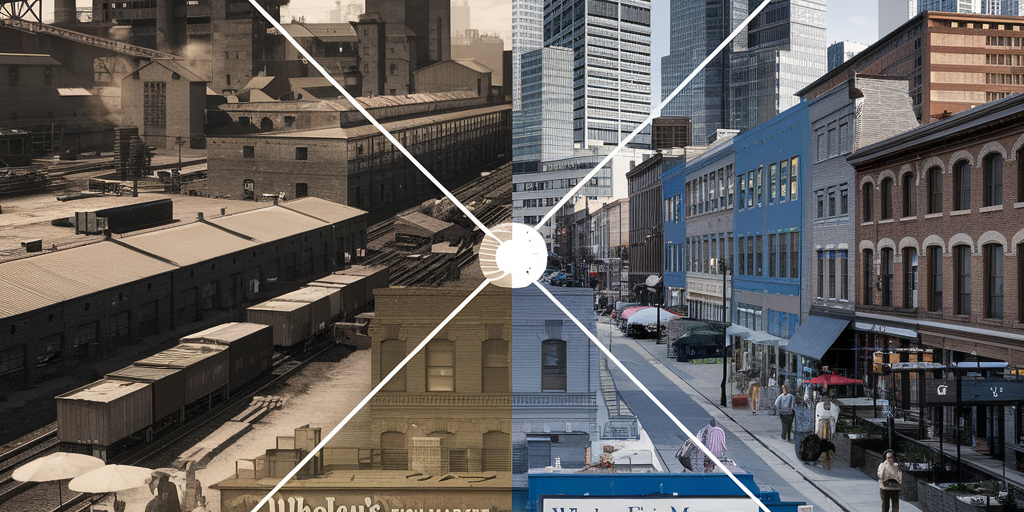The Strip District: Pittsburgh’s Ever-Evolving Heart
The Strip District is one of Pittsburgh’s most dynamic neighborhoods, a place where the echoes of industrial might mingle with the buzz of modern innovation. Stretching along the Allegheny River just northeast of Downtown, this vibrant corridor has reinvented itself time and again—from a gritty industrial hub to a bustling wholesale market, and now a thriving center for food, culture, and technology. Its story is a testament to Pittsburgh’s resilience, and today, it stands as a living bridge between the city’s storied past and its ambitious future.
The Industrial Beginnings (1800s–Early 1900s)
In the 19th century, the Strip District was a cornerstone of Pittsburgh’s ascent as an industrial titan. Its prime location along the river and proximity to railroads made it a natural hub for manufacturing and trade. Factories hummed with activity as ironworks, glass production, and steel mills sprang up along its streets. Immigrant workers—many from Poland, Italy, and Ireland—poured into the area, drawn by jobs and the promise of a new life.
The Pennsylvania Railroad Yard, established in the late 1800s, solidified the Strip’s role as a vital artery in Pittsburgh’s supply chain. Trains loaded with coal, steel, and goods rumbled through, fueling the city’s industrial boom. By the turn of the century, the Strip District was a gritty, smoky engine of progress, its warehouses and foundries shaping Pittsburgh’s reputation as the Steel City.
The Golden Age of Wholesale Markets (Early–Mid 1900s)
As the 20th century dawned, the Strip District shifted gears. Heavy industry gave way to a new identity: the city’s food supply powerhouse. Warehouses once filled with machinery now brimmed with fresh produce, meats, and spices. The Pennsylvania Macaroni Company, founded in 1902, became a neighborhood icon, serving Pittsburgh’s growing Italian-American community and laying the foundation for the Strip’s culinary legacy.
From the 1920s to the 1950s, the Strip was alive with the sights and sounds of commerce. Farmers from across Pennsylvania hauled their harvests to open-air markets, while wholesalers like Reyna Foods and Wholey’s Fish Market thrived. The neighborhood’s streets buzzed with activity as grocers, restaurateurs, and families shopped side by side. Cultural diversity flourished, with Polish delis, Jewish bakeries, and Italian grocers adding flavor to the Strip’s vibrant tapestry.
Decline and Abandonment (1960s–1980s)
The mid-20th century brought dark days to the Strip District. The collapse of Pittsburgh’s steel industry in the 1970s and 1980s hit hard, leaving factories shuttered and jobs scarce. As industries faded, so did the neighborhood’s vitality. Empty warehouses loomed over quiet streets, and the rise of supermarkets and suburban shopping centers siphoned business away from the Strip’s wholesalers.
By the late 1980s, the once-thriving district had fallen into decline. Crime crept into its abandoned corners, and the bustling markets of decades past seemed like a distant memory. Yet, beneath the decay, the Strip’s sturdy bones—its historic buildings and unbeatable location—hinted at the potential for rebirth.
Revitalization and a Cultural Renaissance (1990s–2000s)
The 1990s marked the beginning of the Strip District’s comeback. Small business owners, artists, and entrepreneurs saw opportunity in its weathered warehouses and began transforming the neighborhood. Specialty markets, coffee shops, and nightclubs breathed new life into the streets, drawing a fresh crowd of locals and visitors.
Food remained the Strip’s heartbeat. Primanti Bros., with its legendary sandwiches piled high with fries and coleslaw, became a pilgrimage site for food lovers. New vendors joined stalwarts like Wholey’s and Penn Mac, offering everything from gourmet treats to international flavors. Meanwhile, nightlife blossomed—places like Roland’s Seafood Grill and Lefty’s turned the Strip into a hotspot for live music and late-night revelry, cementing its status as a cultural destination.
A Tech and Innovation Boom (2010s–Present)
Today, the Strip District is undergoing its latest transformation, emerging as a hub for technology and innovation. The Pittsburgh Technology Center and giants like Google and Argo AI have set up shop, drawn by the neighborhood’s urban energy and historic charm. Robotics firms and biomedical startups now call the Strip home, echoing Pittsburgh’s shift from steel to cutting-edge industries.
Luxury apartments, coworking spaces, and boutique hotels have risen alongside repurposed warehouses, like The Terminal and The Stacks, blending modern flair with industrial roots. Yet, the Strip hasn’t lost its soul—businesses like Wholey’s, Penn Mac, and Mon Aimee Chocolat keep its historic spirit alive, thriving amid trendy eateries and upscale shops. It’s a neighborhood where you can grab a fish sandwich in the morning and code groundbreaking software by afternoon.
A Legacy of Resilience
The Strip District’s journey—from industrial powerhouse to food mecca, and now tech trailblazer—mirrors Pittsburgh’s own evolution. It’s a place that refuses to stand still, adapting to every challenge while holding fast to its unique identity. Whether you’re strolling its markets, dining at a historic haunt, or working in a sleek office, you’re part of a story that’s still unfolding.
For history buffs and newcomers alike, the Strip District offers a front-row seat to Pittsburgh’s past and future—a neighborhood where every brick, every sandwich, and every startup tells a tale of reinvention.









